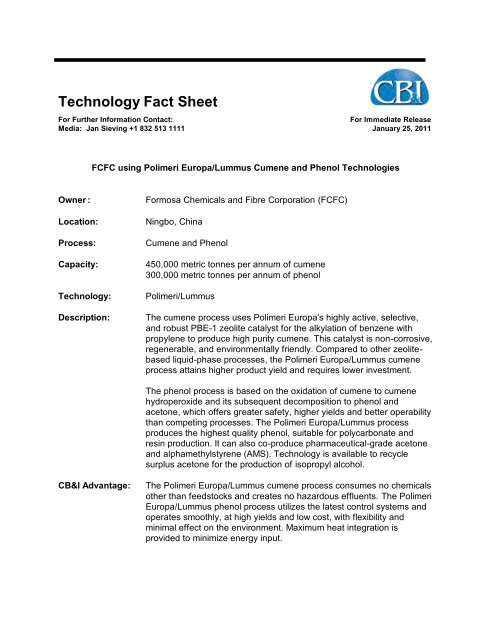FCFC using Polimeri Europa/Lummus Cumene and Phenol - CB&I
FCFC using Polimeri Europa/Lummus Cumene and Phenol - CB&I FCFC using Polimeri Europa/Lummus Cumene and Phenol - CB&I
Technology Fact SheetFor Further Information Contact:For Immediate ReleaseMedia: Jan Sieving +1 832 513 1111 January 25, 2011FCFC using Polimeri Europa/Lummus Cumene and Phenol TechnologiesOwner :Location:Process:Capacity:Technology:Description:Formosa Chemicals and Fibre Corporation (FCFC)Ningbo, ChinaCumene and Phenol450,000 metric tonnes per annum of cumene300,000 metric tonnes per annum of phenolPolimeri/LummusThe cumene process uses Polimeri Europa's highly active, selective,and robust PBE-1 zeolite catalyst for the alkylation of benzene withpropylene to produce high purity cumene. This catalyst is non-corrosive,regenerable, and environmentally friendly. Compared to other zeolitebasedliquid-phase processes, the Polimeri Europa/Lummus cumeneprocess attains higher product yield and requires lower investment.The phenol process is based on the oxidation of cumene to cumenehydroperoxide and its subsequent decomposition to phenol andacetone, which offers greater safety, higher yields and better operabilitythan competing processes. The Polimeri Europa/Lummus processproduces the highest quality phenol, suitable for polycarbonate andresin production. It can also co-produce pharmaceutical-grade acetoneand alphamethylstyrene (AMS). Technology is available to recyclesurplus acetone for the production of isopropyl alcohol.CB&I Advantage:The Polimeri Europa/Lummus cumene process consumes no chemicalsother than feedstocks and creates no hazardous effluents. The PolimeriEuropa/Lummus phenol process utilizes the latest control systems andoperates smoothly, at high yields and low cost, with flexibility andminimal effect on the environment. Maximum heat integration isprovided to minimize energy input.
- Page 2: Met-Ed ®Penelec ®Penn Power ®Fir
Technology Fact SheetFor Further Information Contact:For Immediate ReleaseMedia: Jan Sieving +1 832 513 1111 January 25, 2011<strong>FCFC</strong> <strong>using</strong> <strong>Polimeri</strong> <strong>Europa</strong>/<strong>Lummus</strong> <strong>Cumene</strong> <strong>and</strong> <strong>Phenol</strong> TechnologiesOwner :Location:Process:Capacity:Technology:Description:Formosa Chemicals <strong>and</strong> Fibre Corporation (<strong>FCFC</strong>)Ningbo, China<strong>Cumene</strong> <strong>and</strong> <strong>Phenol</strong>450,000 metric tonnes per annum of cumene300,000 metric tonnes per annum of phenol<strong>Polimeri</strong>/<strong>Lummus</strong>The cumene process uses <strong>Polimeri</strong> <strong>Europa</strong>'s highly active, selective,<strong>and</strong> robust PBE-1 zeolite catalyst for the alkylation of benzene withpropylene to produce high purity cumene. This catalyst is non-corrosive,regenerable, <strong>and</strong> environmentally friendly. Compared to other zeolitebasedliquid-phase processes, the <strong>Polimeri</strong> <strong>Europa</strong>/<strong>Lummus</strong> cumeneprocess attains higher product yield <strong>and</strong> requires lower investment.The phenol process is based on the oxidation of cumene to cumenehydroperoxide <strong>and</strong> its subsequent decomposition to phenol <strong>and</strong>acetone, which offers greater safety, higher yields <strong>and</strong> better operabilitythan competing processes. The <strong>Polimeri</strong> <strong>Europa</strong>/<strong>Lummus</strong> processproduces the highest quality phenol, suitable for polycarbonate <strong>and</strong>resin production. It can also co-produce pharmaceutical-grade acetone<strong>and</strong> alphamethylstyrene (AMS). Technology is available to recyclesurplus acetone for the production of isopropyl alcohol.CB&I Advantage:The <strong>Polimeri</strong> <strong>Europa</strong>/<strong>Lummus</strong> cumene process consumes no chemicalsother than feedstocks <strong>and</strong> creates no hazardous effluents. The <strong>Polimeri</strong><strong>Europa</strong>/<strong>Lummus</strong> phenol process utilizes the latest control systems <strong>and</strong>operates smoothly, at high yields <strong>and</strong> low cost, with flexibility <strong>and</strong>minimal effect on the environment. Maximum heat integration isprovided to minimize energy input.
Met-Ed ®Penelec ®Penn Power ®FirstEnergy CompaniesYour First Source forEnergy SavingsHow much does a home energy audit cost?The cost for a comprehensive home energy audit varies widely depending on the size <strong>and</strong> complexity ofyour home. Prices are individually set by each home energy expert participating in the Whole HouseProgram. We recommend that you contact several companies to decide which one is right for you. Becareful of low-price audits you may see advertised by companies not participating in this program; suchaudits may not include the sophisticated diagnostic testing by BPI-certified contractors featuredin Whole House Program audits.What does it mean to be BPI-certified?The Building Performance Institute (BPI) is a non-profit developer of technical st<strong>and</strong>ards for homeperformance <strong>and</strong> weatherization retrofit work. BPI st<strong>and</strong>ards are recognized across North America.BPI is a resource for building science technology that sets st<strong>and</strong>ards for assessing <strong>and</strong> improving theenergy performance as well as the health <strong>and</strong> safety of homes. Contractors who are BPI-certified haveundergone training <strong>and</strong> testing to demonstrate the ability to do work in accordance with BPI st<strong>and</strong>ards.How can I find a BPI-certified participating contractor?You can find a participating BPI-certified contractor in your area by <strong>using</strong> the search tool found athttp://energysavepa-home.com/wholehouse/home-energy-expertWill the contractor explain the findings from the audit?Yes, the contractor will explain the results of the home energy audit <strong>and</strong> recommend energy efficiencyimprovements you can make to your home. You may choose to implement some or all of the improvements;the more improvements you make, the greater the energy savings.What is a blower door test?A blower door test measures air leakage between the conditioned (heated <strong>and</strong>/orcooled) parts of your home <strong>and</strong> unconditioned areas (e.g., unheated attics, crawlspaces <strong>and</strong> the outdoors). In preparation for a blower door test, a powerful fan ismounted into the frame of an exterior door. The fan pulls air out of the home,reducing the internal air pressure, while outside air flows in through unsealedcracks <strong>and</strong> openings in your home. The data collected during a blower door testwill allow the contractor to quantify the amount of air leakage in your home <strong>and</strong>suggest energy efficiency improvements you can install.How long will it take to perform a home energy audit?A thorough home energy audit may take up to three hours to perform.Do I need to be home during the home energy audit?Yes, the homeowner must be present during the home energy audit.http://energysavepa-home.com/wholehouse/whole-house-program2



